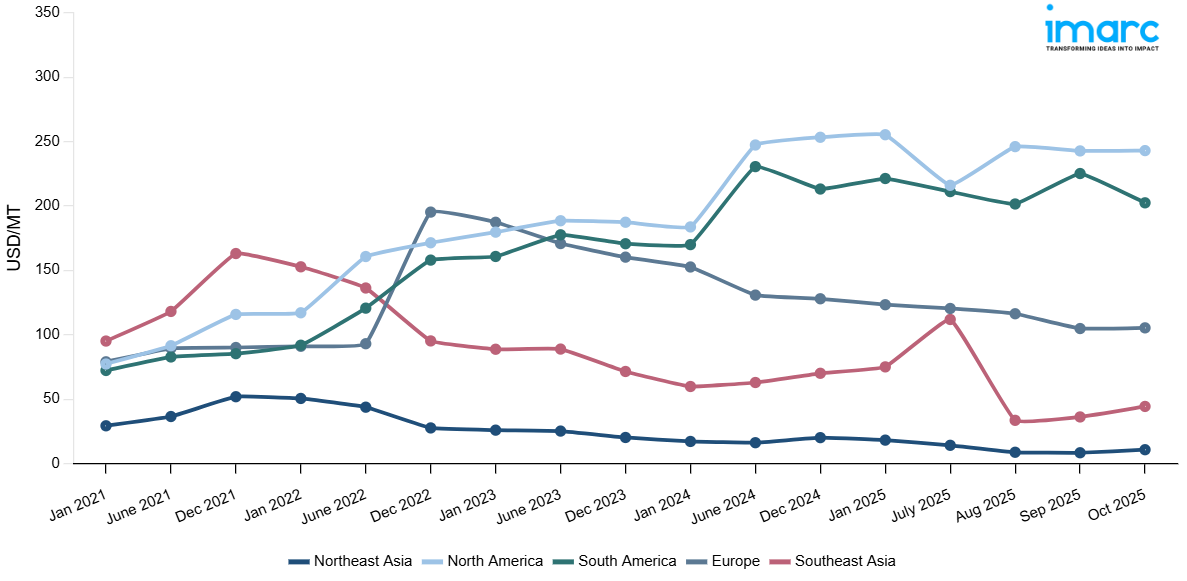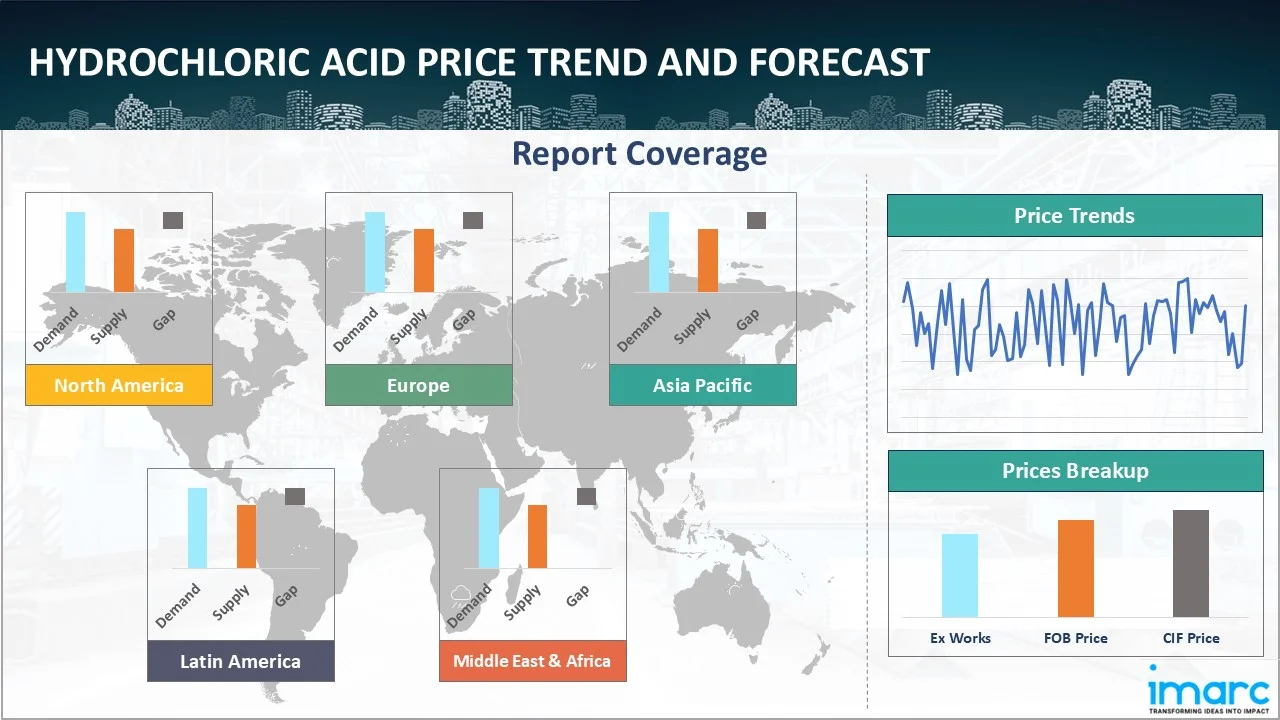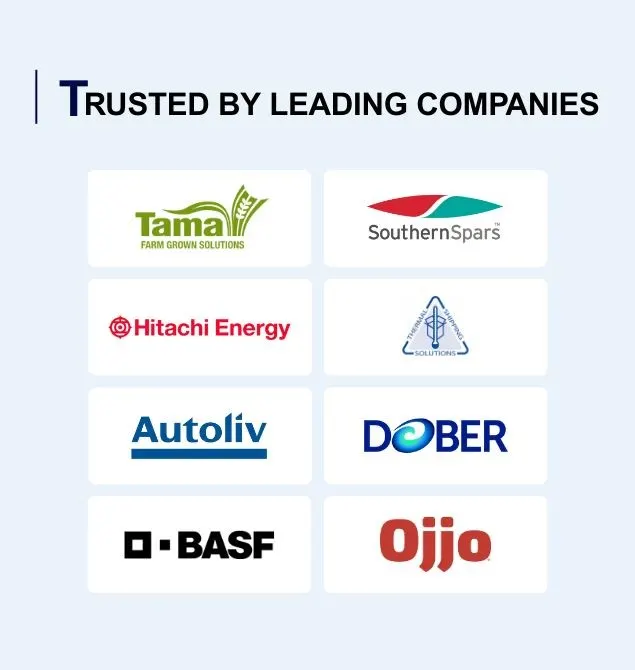
Hydrochloric Acid Prices, Trend, Chart, Demand, Market Analysis, News, Historical and Forecast Data Report 2025 Edition
Hydrochloric Acid Price Trend, Index and Forecast
Track real-time and historical hydrochloric acid prices across global regions. Updated monthly with market insights, drivers, and forecasts.
Hydrochloric Acid Prices October 2025
| Region | Price (USD/MT) | Latest Movement |
|---|---|---|
| Northeast Asia | 10.74 | 28.3% ↑ Up |
| Europe | 105.34 | 0.5% ↑ Up |
| South America | 202.42 | -10.1% ↓ Down |
| Southeast Asia | 44.33 | 22.6% ↑ Up |
| North America | 242.97 | 0.1% ↑ Up |
Hydrochloric Acid Price Index (USD/MT):
The chart below highlights monthly hydrochloric acid prices across different regions.

Get Access to Monthly/Quaterly/Yearly Prices, Request Sample
Market Overview Q3 Ending September 2025
Northeast Asia: The decline was primarily influenced by moderate downstream demand from the chemical and steel sectors. Supply-side factors included steady domestic production in China, South Korea, and Japan, which prevented shortages despite export fluctuations. Cost components such as international shipping, port handling, and domestic logistics remained relatively stable, while minor currency fluctuations slightly reduced import-adjusted costs. Additionally, compliance costs associated with environmental and occupational safety standards, particularly in chemical manufacturing, were consistent, contributing no additional upward pressure on prices. Regional market dynamics were further shaped by subdued industrial activity in end-user sectors, which led to cautious procurement behavior, resulting in lower spot market rates.
Europe: Weakening demand from steel, chemical, and water treatment industries was a key contributor to the downward trend, as many producers scaled back orders amid slowing industrial output. Supply-side considerations included consistent local production across Germany, France, and Italy, coupled with imports from Northeast Asia that faced minor transportation delays but no significant shortages. Key cost determinants such as customs duties, port handling fees, and energy costs remained stable, although currency movements between the Euro and USD slightly eased the cost of imported material. Compliance costs related to environmental regulations and EU chemical safety standards were largely unchanged. Collectively, these factors resulted in moderate price declines, with buyers leveraging lower spot prices to replenish inventories strategically.
South America: The upward movement was driven by rising demand from mining and metal processing industries, particularly in Brazil and Chile, where HCl is used for ore leaching and purification. Supply-side pressures, including limited domestic production capacity and increased reliance on imports, contributed to tighter availability and upward pricing. Transportation and logistics costs, including port handling and inland distribution, rose due to increased fuel prices and infrastructure congestion. Currency fluctuations, particularly the Brazilian Real against the USD, amplified the local cost of imports.
Southeast Asia: Demand growth from fertilizer production, steel manufacturing, and chemical processing in countries such as Thailand, Vietnam, and Indonesia supported the price rise. On the supply side, domestic production remained stable, but export demand from neighboring regions tightened local availability, contributing to upward pricing pressure. Key cost factors included port handling charges, logistics fees, and moderate fluctuations in shipping costs. Currency variations, especially the Thai Baht and Indonesian Rupiah against the USD, slightly increased import-adjusted costs. Compliance with local environmental regulations and safety standards added marginal costs, while international shipping remained relatively smooth.
North America: The modest decrease was influenced by slower demand from chemical processing, oilfield applications, and water treatment sectors, which reduced immediate procurement requirements. Domestic production from US and Canadian manufacturers remained steady, maintaining market balance despite fluctuations in import volumes. Cost components such as port handling, inland logistics, and energy expenses remained largely stable, while minimal currency volatility had little effect on pricing. Compliance costs for environmental regulations, worker safety, and chemical handling were consistent with previous quarters.
Hydrochloric Acid Price Trend, Market Analysis, and News
IMARC's latest publication, “Hydrochloric Acid Prices, Trend, Chart, Demand, Market Analysis, News, Historical and Forecast Data Report 2025 Edition,” presents a detailed examination of the hydrochloric acid market, providing insights into both global and regional trends that are shaping prices. This report delves into the spot price of hydrochloric acid at major ports and analyzes the composition of prices, including FOB and CIF terms. It also presents detailed hydrochloric acid prices trend analysis by region, covering North America, Europe, Asia Pacific, Latin America, and Middle East and Africa. The factors affecting hydrochloric acid pricing, such as the dynamics of supply and demand, geopolitical influences, and sector-specific developments, are thoroughly explored. This comprehensive report helps stakeholders stay informed with the latest market news, regulatory updates, and technological progress, facilitating informed strategic decision-making and forecasting.

Hydrochloric Acid Industry Analysis
The global hydrochloric acid industry size reached USD 2.52 Billion in 2024. By 2033, IMARC Group expects the market to reach USD 3.95 Billion, at a projected CAGR of 4.85% during 2025-2033. The market is driven by the expanding demand in metal processing, chemical production, water treatment, and mining sectors, increasing use in pharmaceutical and fertilizer applications, and investments in infrastructure and industrial expansion in developing regions.
Latest developments in the Hydrochloric Acid Industry:
- May 2025: Regional Acid Production LP (RAP) announced the development of a state-of-the-art hydrochloric acid (HCl) manufacturing facility in Port Lavaca, Texas. The facility is designed to commence operations in early 2026 and aimed to produce ultra-high-purity HCl tailored to meet the stringent requirements of the semiconductor and advanced technology manufacturing sectors.
- December 2024: Chlorum Solutions USA LLC developed a small-scale chlor-alkali plant in Casa Grande, Arizona, to locally produce hydrochloric acid (HCl), sodium hypochlorite, and caustic soda. The USD 70 Million facility will use advanced membrane technology to reduce reliance on chlorine gas imports, enhance supply chain resilience, and improve safety.
- July 2024: John Cockerill and Baosteel launched a "2*20m³/h Fluidized Bed Acid Regeneration" project to treat hydrochloric acid waste and recover metal ions and hydrogen chloride, reducing environmental impact and improving resource efficiency.
- April 2022: Aditya Birla Group launched its first chlor-alkali plant in East Godavari, Andhra Pradesh. The plant, with a capacity of 150,000 Tons per year, produces caustic soda, hydrochloric acid, and other chemicals. It strengthens the group’s chlor-alkali presence in India and supports growth in sectors like pharmaceuticals and agrochemicals.
Product Description
Hydrochloric acid (HCL) is an aqueous solution of hydrogen chloride, which is an acidic gas. It is a colorless, dense, and nonflammable gas with a distinctive pungent and irritating smell. Hydrochloric acid possesses a strong corrosive nature towards metals, tissues, eyes, and the respiratory system. On a commercial scale, HCL is prepared by reacting sodium chloride (NaCl) with concentrated sulphuric acid (H2SO4). Other methods of preparation involve organic by-product synthesis, waste incineration, and thermal decomposition of hydrated heavy metals.
It is widely used in cleaning, electroplating, leather tanning, pickling, refining, and prediction of a variety of products, such as rubber, pharmaceuticals, and chemicals. Hydrochloric acid is a type of mineral acid that reacts vigorously with organic and inorganic bases, such as amines, amides, metal oxides, and metal hydroxides. It also readily reacts with sulfides, carbides, borides, and phosphides to generate toxic or flammable gases.
Report Coverage
| Key Attributes | Details |
|---|---|
| Product Name | Hydrochloric Acid |
| Report Features | Exploration of Historical Trends and Market Outlook, Industry Demand, Industry Supply, Gap Analysis, Challenges, Hydrochloric Acid Price Analysis, and Segment-Wise Assessment. |
| Currency/Units | US$ (Data can also be provided in local currency) or Metric Tons |
| Region/Countries Covered | The current coverage includes analysis at the global and regional levels only. Based on your requirements, we can also customize the report and provide specific information for the following countries: Asia Pacific: China, India, Indonesia, Pakistan, Bangladesh, Japan, Philippines, Vietnam, Thailand, South Korea, Malaysia, Nepal, Taiwan, Sri Lanka, Hongkong, Singapore, Australia, and New Zealand* Europe: Germany, France, United Kingdom, Italy, Spain, Russia, Turkey, Netherlands, Poland, Sweden, Belgium, Austria, Ireland, Switzerland, Norway, Denmark, Romania, Finland, Czech Republic, Portugal and Greece* North America: United States and Canada Latin America: Brazil, Mexico, Argentina, Columbia, Chile, Ecuador, and Peru* Middle East & Africa: Saudi Arabia, UAE, Israel, Iran, South Africa, Nigeria, Oman, Kuwait, Qatar, Iraq, Egypt, Algeria, and Morocco* *The list of countries presented is not exhaustive. Information on additional countries can be provided if required by the client. |
| Information Covered for Key Suppliers |
|
| Customization Scope | The report can be customized as per the requirements of the customer |
| Report Price and Purchase Option |
Plan A: Monthly Updates - Annual Subscription
Plan B: Quarterly Updates - Annual Subscription
Plan C: Biannually Updates - Annual Subscription
|
| Post-Sale Analyst Support | 360-degree analyst support after report delivery |
| Delivery Format | PDF and Excel through email (We can also provide the editable version of the report in PPT/Word format on special request) |
Key Benefits for Stakeholders:
- IMARC’s report presents a detailed analysis of hydrochloric acid pricing, covering global and regional trends, spot prices at key ports, and a breakdown of FOB and CIF prices.
- The study examines factors affecting hydrochloric acid price trend, including input costs, supply-demand shifts, and geopolitical impacts, offering insights for informed decision-making.
- The competitive landscape review equips stakeholders with crucial insights into the latest market news, regulatory changes, and technological advancements, ensuring a well-rounded, strategic overview for forecasting and planning.
- IMARC offers various subscription options, including monthly, quarterly, and biannual updates, allowing clients to stay informed with the latest market trends, ongoing developments, and comprehensive market insights. The hydrochloric acid price charts ensure our clients remain at the forefront of the industry.
Key Questions Answered in This Report
The hydrochloric acid prices in October 2025 were 10.74 USD/MT in Northeast Asia, 105.34 USD/MT in Europe, 202.42 USD/MT in South America, 44.33 USD/MT in Southeast Asia, and 242.97 USD/MT in North America.
The hydrochloric acid pricing data is updated on a monthly basis.
We provide the pricing data primarily in the form of an Excel sheet and a PDF.
Yes, our report includes a forecast for hydrochloric acid prices.
The regions covered include North America, Europe, Asia Pacific, Middle East, and Latin America. Countries can be customized based on the request (additional charges may be applicable).
Yes, we provide both FOB and CIF prices in our report.
Need more help?
- Speak to our experienced analysts for insights on the current market scenarios.
- Include additional segments and countries to customize the report as per your requirement.
- Gain an unparalleled competitive advantage in your domain by understanding how to utilize the report and positively impacting your operations and revenue.
- For further assistance, please connect with our analysts.
Why Choose Us
IMARC offers trustworthy, data-centric insights into commodity pricing and evolving market trends, enabling businesses to make well-informed decisions in areas such as procurement, strategic planning, and investments. With in-depth knowledge spanning more than 1000 commodities and a vast global presence in over 150 countries, we provide tailored, actionable intelligence designed to meet the specific needs of diverse industries and markets.
1000
+Commodities
150
+Countries Covered
3000
+Clients
20
+Industry
Robust Methodologies & Extensive Resources
IMARC delivers precise commodity pricing insights using proven methodologies and a wealth of data to support strategic decision-making.
Subscription-Based Databases
Our extensive databases provide detailed commodity pricing, import-export trade statistics, and shipment-level tracking for comprehensive market analysis.
Primary Research-Driven Insights
Through direct supplier surveys and expert interviews, we gather real-time market data to enhance pricing accuracy and trend forecasting.
Extensive Secondary Research
We analyze industry reports, trade publications, and market studies to offer tailored intelligence and actionable commodity market insights.
Trusted by 3000+ industry leaders worldwide to drive data-backed decisions. From global manufacturers to government agencies, our clients rely on us for accurate pricing, deep market intelligence, and forward-looking insights.
 Request Customization
Request Customization
 Inquire Before Buying
Inquire Before Buying
 Speak to an Analyst
Speak to an Analyst Request Brochure
Request Brochure




.webp)




.webp)












